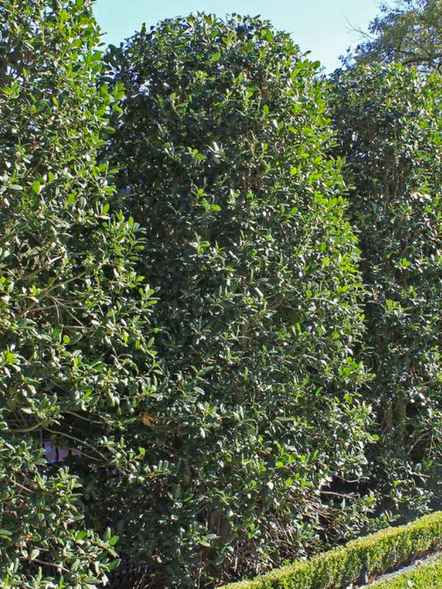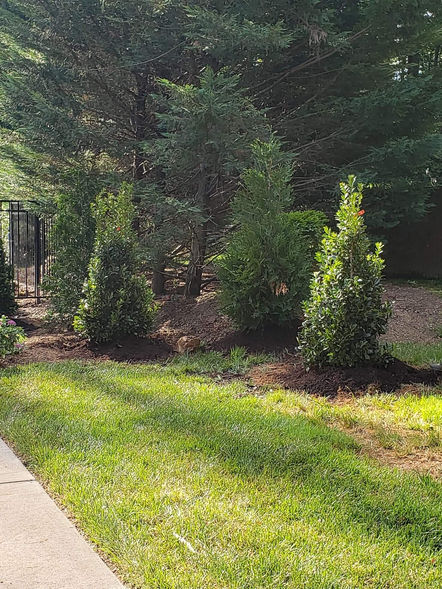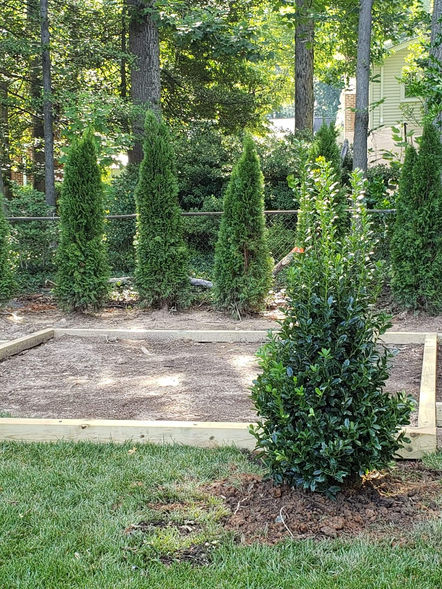
Nellie Stevens Holly
Growing Zones: 6 – 9
Growth Rate: 2 – 3 FT / Year
Mature Height: 15 – 25 FT
Mature Width: 10 – 15 FT
Growth Form: Hedge or Tree Form
Foliage Color: Dark Green with Bright Red Berries (in winter)
Soil Conditions: Adapts to a wide range of well-drained soils
Recommended Plant Spacing: 4 – 6 FT (for hedge use)
About our Nellie Stevens Holly
The Nellie Stevens Holly is a timeless evergreen, prized for its dense foliage, upright form, and vibrant winter berries. A natural choice for privacy hedges and ornamental focal points, this hybrid holly brings both beauty and function to any landscape. Its lush, dark green leaves are thick and glossy, creating a stately, year-round backdrop that only gets better with age.
Typically reaching mature heights of 15 to 25 feet and spreading 10 to 15 feet wide, Nellie Stevens Holly grows into a naturally pyramidal shape that lends elegance to formal and informal garden designs alike. Thanks to its fast growth rate of up to 2 to 3 feet per year, it is one of the most efficient and attractive options for establishing living screens, windbreaks, or property dividers.
The plant thrives in USDA Zones 6 to 9, making it versatile across a wide geographic range. It adapts easily to various well-drained soils, from sandy loam to heavier clay, and performs reliably in both full sun and partial shade. Its low-maintenance nature and impressive drought tolerance make it a favorite among landscapers and homeowners looking for long-term value with minimal upkeep.
One of its most striking features appears in late fall and winter, when bright red berries contrast beautifully against its evergreen foliage. These berries not only enhance its visual appeal but also provide a valuable food source for birds and other wildlife.
Whether shaped into a formal hedge or grown as a standalone tree, the Nellie Stevens Holly offers privacy, elegance, and year-round interest. Its adaptability, growth speed, and classic beauty make it a staple in Southern and Mid-Atlantic gardens — a plant that protects, decorates, and elevates any landscape it inhabits.

Nellie Stevens Holly Sizes & Prices
Choose the dimensions for your privacy screen based on your patience level and budget. Larger sizes offer immediate privacy but at a higher cost. Ultimately, all trees will achieve the desired outcome, so your willingness to wait is key.
Previous Jobs
Watering Instructions
Understanding Watering Needs: Nellie Stevens Holly prefers evenly moist soil, especially during its establishment phase, but does not tolerate soggy conditions. Proper watering helps promote a strong root system and vibrant growth. Striking a balance between adequate moisture and good drainage is key to keeping the plant healthy.
Soil Type: Plant in well-draining soil with a slightly acidic to neutral pH. Nellie Stevens Holly adapts well to various soil types, but amending heavy clay or poorly drained soil with organic matter such as compost, pine bark, or sand can improve drainage and prevent root issues.
Watering Frequency: Water when the top 2–3 inches of soil feels dry to the touch. During the first year after planting, maintain a consistent watering schedule to encourage deep root development. Once established, the tree is fairly drought-tolerant but will benefit from deep watering during dry spells.
Seasonal Variations: Increase watering frequency during hot summer months or prolonged dry periods. In cooler seasons, reduce watering to avoid oversaturation when the tree's water needs are lower.
Watering Technique: Apply water directly to the base of the plant, soaking the root zone thoroughly. Water slowly to ensure deep penetration without runoff. Using a soaker hose or drip irrigation system is ideal for maintaining consistent moisture levels.
Avoid Overwatering: Soggy or compacted soil can cause root rot and fungal problems. Always check soil moisture before watering. If you notice standing water or consistently wet soil, reduce the frequency and improve drainage.
Mulching: Apply a 2–3 inch layer of mulch around the base of the tree, keeping it a few inches away from the trunk. Mulch helps regulate soil temperature, retain moisture, and prevent weeds—but avoid piling it against the trunk, which can lead to rot.
Rainwater or Tap Water: Nellie Stevens Holly is not overly sensitive to tap water, but using rainwater is ideal when available. Avoid using water that has been softened with salts, as salt buildup can damage the roots over time.
Temperature Consideration: Avoid watering during the heat of the day or when the ground is frozen. Early morning or late afternoon is best for efficient moisture absorption.
Monitor for Signs of Stress: Watch for yellowing leaves (a sign of overwatering) or drooping, dry foliage (a sign of underwatering). Adjust your watering habits based on the tree’s condition and the weather. Healthy Nellie Stevens Holly trees will have firm, glossy green leaves and upright growth.
Trimming Instructions
Timing: The best time to trim Nellie Stevens Holly is during its active growing season—typically late spring through early fall. Avoid heavy pruning during the colder months or when the tree is under stress (such as during drought or transplant shock), as this can hinder recovery and new growth.
Tools: Use clean, sharp pruning shears or loppers to make smooth cuts without tearing the bark. Disinfect your tools before and after use to prevent the spread of diseases between plants. Wearing gloves is also recommended to protect your hands from the holly’s spiny leaves.
Identify Areas for Trimming: Walk around the plant and locate any areas that require attention. Look for dead, broken, or diseased branches, as well as any branches that are growing inward, crossing over others, or disrupting the natural form of the tree.
Remove Dead or Diseased Branches: Begin by cutting away any unhealthy or damaged wood. Make your cuts just above a healthy bud or lateral branch to encourage new growth. Prompt removal of these branches helps maintain the plant’s health and appearance.
Shape and Thin Out Growth: Trim back overgrown or leggy branches to maintain your desired height and width. Focus on shaping the outer form while also selectively thinning some interior branches to improve airflow and sunlight penetration, which helps reduce the risk of disease.
Consider Natural Form: Nellie Stevens Holly has a naturally dense, pyramidal shape that requires minimal shaping. When trimming, aim to maintain this form while controlling overall size. Avoid harsh pruning that flattens or distorts the plant’s natural silhouette.






























